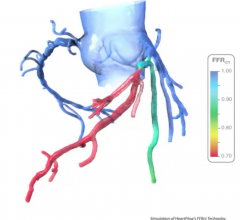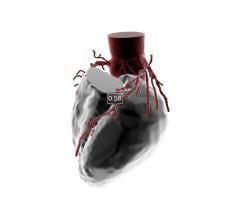If you enjoy this content, please share it with a colleague
HeartFlow
RELATED CONTENT
July 15, 2021 — HeartFlow, which has commercialized noninvasive computed tomography derived fractional flow reserve (FFR ...
October 22, 2020 – In the FORECAST randomized clinical trial, the use of fractional flow reserve (FFR) derived from comp ...
Late-breaking results confirm the HeartFlow FFRct (fractional flow reserve computed tomography) Analysis enables efficient identification of which patients, despite symptoms suggestive of coronary artery disease (CAD), have a low risk of adverse cardiovascular events and can safely avoid invasive testing out to one year. These results from the ADVANCE trial were presented as a late-breaking trial during the American College of Cardiology’s (ACC) 68th Annual Scientific Session, March 16-18 in New Orleans, and simultaneously published in the Journal of the American College of Cardiology (JACC): Cardiovascular Imaging.
HeartFlow Inc. announced that UnitedHealthcare now covers the HeartFlow FFRct Analysis, extending access to their 45 million beneficiaries. With this new coverage, more than 235 million people in the United States now have access to the HeartFlow Analysis.
HeartFlow Inc. announced that the National Health Service (NHS) England has chosen the HeartFlow FFRct (fractional flow reserve computed tomography) Analysis as part of the Innovation and Technology Payment (ITP) program. The HeartFlow Analysis was chosen as a new technology to be funded by ITP through a competitive process of nearly 300 applicants. It is the only ITP recipient focused on coronary artery disease (CAD), which affects 2.3 million people in the U.K., according to the British Heart Foundation.
March 13, 2018 – HeartFlow, Inc. today announced that it has entered into a licensing and technology transfer agreement ...
HeartFlow Inc. announced that Health Care Service Corp. (HCSC), which operates Blue Cross and Blue Shield plans in five states, has issued a medical policy for the HeartFlow FFRct Analysis, a non-invasive technology that helps clinicians diagnose and treat patients with suspected coronary artery disease (CAD). HCSC — which operates Blue Cross Blue Shield plans in Illinois, Montana, New Mexico, Oklahoma and Texas — has determined that the use of noninvasive fractional flow reserve (FFR) following a positive coronary computed tomography (CT) angiogram may be considered medically necessary to guide decisions about the use of invasive coronary angiography in patients with stable chest pain at intermediate risk of CAD.
HeartFlow Inc. announced that four Blue Cross Blue Shield companies have each issued a positive medical policy for the HeartFlow FFRct (fractional flow reserve-computed tomography) Analysis.
The National Institute for Health and Care Excellence (NICE) in the United Kingdom recently issued guidance for use of the HeartFlow FFRct (fractional flow reserve computed tomography) Analysis to help determine the cause of stable chest pain in patients. Developed by HeartFlow Inc., the HeartFlow FFRct Analysis is the first non-invasive technology to provide insight into both the extent of coronary artery disease and the impact that disease has on blood flow to the heart, enabling clinicians to select an appropriate treatment.
A discussion with Simon Dixon, M.D., MBChB, on the use of fractional flow reserve-computed tomography (FFR-CT) to ...


 July 15, 2021
July 15, 2021 







